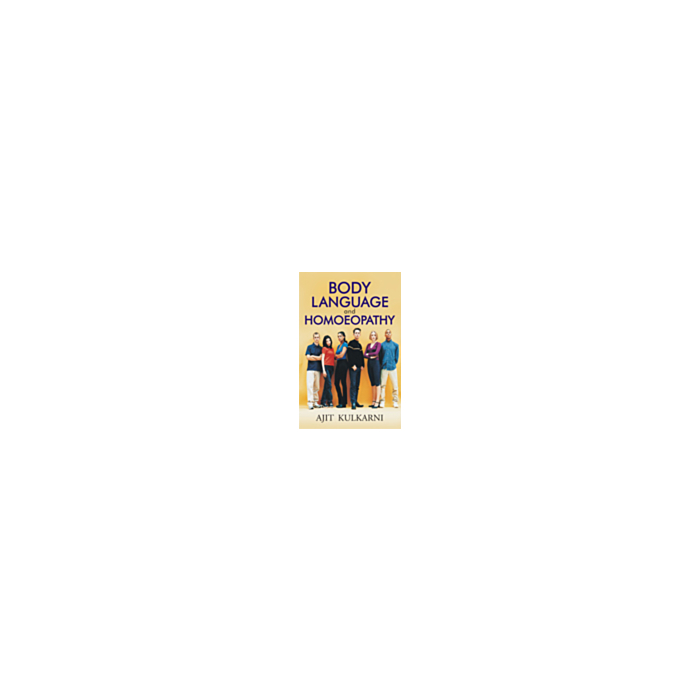Body Language and Homeopathy
Delen op sociale media
| ISBN | 9788131908884 |
|---|---|
| Auteur | Ajit Kulkarni |
| Type | Hardback |
| Taal | English |
| Publicatiedatum | 2010 |
| Pagina's | 792 |
| Uitgever | B. Jain |
| Recensie | This book review is reprinted with the permission from the Autumn 2010 Edition of The Homeopath. Reviewed by Francis Treuherz Here is a revolutionary book, a book to change one's perceptions of patients and their remedies based on modern western psychology and kinesics, that does not ask one to change homeopathic philosophy one iota. In fact the ideas and information contained in this fat volume are a great enhancement, and of value equally to students and experienced homeopaths. The long second section gives the background with a detailed examination of human communication through body language, posture, gesture, expression, voice, touch, space and distance and more. Communication skills are early in the book related to homeopathy and observation and interaction with our patients. There are copious examples and many photographs, using neutral models and well-known figures, for example Saddam Hussein posed with his fists clenched over his crotch. I recall George Vithoulkas explaining how the only gesture observed on an unconscious patient he saw in intensive care was this, so he prescribed Hyoscyamus. While this example may appear glaringly obvious once it is explained, there are great subtleties in this book; a huge range of phenomena is explored. The first and last sections deal with homeopathy in an exciting way, photographs, cases, explanations, repertory work, new ideas on families, all related to smiles, touch, gesture as a universal language, when to remain silent, the value of mirroring. The contents range from our remedy kingdoms compared to body language, tips for successful practice and the laptop as a potential barrier. I am not sure that all the examples work. There are references to signatures so that a walnut is shown in section and related to the brain. But an avocado related to the uterus by its shape fails as the photo is of an aubergine. As a final example I shall cite the description of 'combative mode' as I just saw such a patient: Hands on hips, redness of face, short or rapid breath, frequent repetition of certain words and phrases, rapid loud speech, rapid body motions, locked jaw, tightly closed lips, scowling, stiff rigid posture, clenched fist, false sarcastic laughter, frequent exaggerated use of pointers, pouting of lips, firm handshake, strong eye contact. In other circumstances you might wish to cross the road but there is a comparison with fugitive mode and in both modes forward and back, reflective and responsive are compared and all makes sense when you read the examples. Just about all was taught was never to examine a Platina patient without a chaperone in the house, but not how to recognise one soon enough to be useful. It is all here in this fat wellbound new textbook. |
Recensie
This book review is reprinted with the permission from the Autumn 2010 Edition of The Homeopath.
Reviewed by Francis Treuherz
Here is a revolutionary book, a book to change one's perceptions of patients and their remedies based on modern western psychology and kinesics, that does not ask one to change homeopathic philosophy one iota. In fact the ideas and information contained in this fat volume are a great enhancement, and of value equally to students and experienced homeopaths.
The long second section gives the background with a detailed examination of human communication through body language, posture, gesture, expression, voice, touch, space and distance and more. Communication skills are early in the book related to homeopathy and observation and interaction with our patients. There are copious examples and many photographs, using neutral models and well-known figures, for example Saddam Hussein posed with his fists clenched over his crotch. I recall George Vithoulkas explaining how the only gesture observed on an unconscious patient he saw in intensive care was this, so he prescribed Hyoscyamus. While this example may appear glaringly obvious once it is explained, there are great subtleties in this book; a huge range of phenomena is explored.
The first and last sections deal with homeopathy in an exciting way, photographs, cases, explanations, repertory work, new ideas on families, all related to smiles, touch, gesture as a universal language, when to remain silent, the value of mirroring. The contents range from our remedy kingdoms compared to body language, tips for successful practice and the laptop as a potential barrier. I am not sure that all the examples work. There are references to signatures so that a walnut is shown in section and related to the brain. But an avocado related to the uterus by its shape fails as the photo is of an aubergine.
As a final example I shall cite the description of 'combative mode' as I just saw such a patient:
Hands on hips, redness of face, short or rapid breath, frequent repetition of certain words and phrases, rapid loud speech, rapid body motions, locked jaw, tightly closed lips, scowling, stiff rigid posture, clenched fist, false sarcastic laughter, frequent exaggerated use of pointers, pouting of lips, firm handshake, strong eye contact. In other circumstances you might wish to cross the road but there is a comparison with fugitive mode and in both modes forward and back, reflective and responsive are compared and all makes sense when you read the examples. Just about all was taught was never to examine a Platina patient without a chaperone in the house, but not how to recognise one soon enough to be useful. It is all here in this fat wellbound new textbook.


